SingleWork curata da Annalisa Perriello con critica di Marta Lock
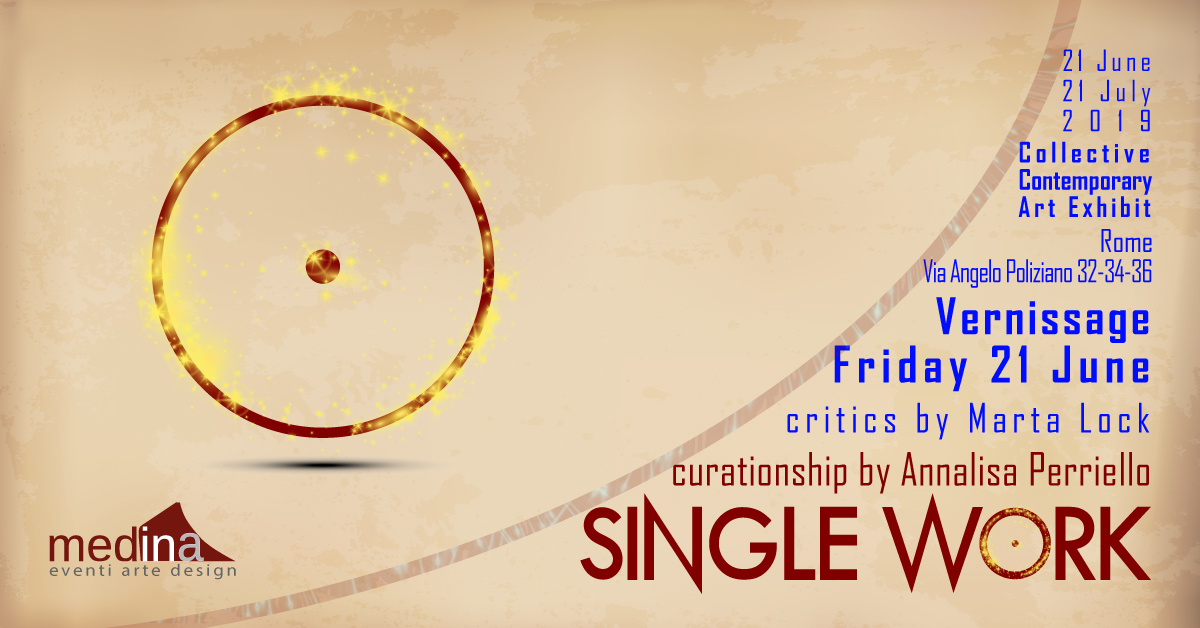
Quando
Date(s) - 21/06/2019 - 21/07/2019
Tutto il giorno
Dove
Medina Roma
SingleWork curata da Annalisa Perriello con critica di Marta Lock
[ITA]
SingleWork curata da Annalisa Perriello con critica di Marta Lock. Dal 21 Giugno al 21 Luglio 2019 negli spazi Medina Roma. Il progetto mette in correlazione opere figurative ed astratte, di pittura, scultura e fotografia. Ogni artista ha la possibilità di esporre un unico lavoro; da qui il concept della mostra “Single Work”: un’opera unica che rappresenta la poetica dell’artista.
CALL APERTA PER TUTTI GLI ARTISTI: PER INFO SCRIVI A info@medinaroma.com
[ENG]
SingleWork curationship by Annalisa Perriello and critics by Marta Lock. From 21 June to 21 July 2019 in Medina Roma concept space. The project correlates figurative and abstract works of painting, sculpture and photography. Each artist has the opportunity to exhibit a single work; hence the concept of the “Single Work” exhibition: a unique work that represents the artist’s poetics.
OPEN CALL FOR ARTISTS: FOR INFO EMAIL TO info@medinaroma.com
Opening: Venerdì 21 Giugno ore 18:00 / Friday June 21th, 2019
Apertura al pubblico/Visit: Lunedì-Venerdì 10:00-13:00 e 15:00-19:00 / Monday-Friday 10am-1pm and 3pm-7pm
SingleWork curata da Annalisa Perriello con critica di Marta Lock
[ITA]
Dal titolo e dal concept emerge esplicitamente l’esposizione dell’unicità come simbolo: ogni artista si cimenterà con la difficile sfida di presentare una sua icona o la sua icona. Una sintesi iconica della propria figura artistica. Sintesi di un periodo, di una fase, di un’esperienza o sintesi universale.
Lo stimolo è la valorizzazione dell’arte contemporanea scendendo nel profondo delle sensazioni umane; o salendo nelle vette più alte, dipende. Infatti attraverso il concetto filosofico dell’unicità e della singolarità è possibile esplodere molte strade: l’uno (dal greco μονάς monas, μόνος monos: “uno”, “singolo”, “unico”, “monade”), ci rimanda ad un concetto di assoluto (che secondo wikipedia è una realtà la cui esistenza non dipende da nessun’altra, ma sussiste in sé e per sé).
Ogni artista sperimenterà la possibilità o la non possibilità di ricondurre la pluralità (degli esseri, delle sensazioni, dei fenomeni, della creatività) ad un’unica sostanza o ad un medesimo principio. Da Pitagora a Platone, dal Rinascimento alla New Age; da matematici a fisici. La Storia del Pensiero si è sempre misurata con tali elaborazioni. Raffreddando la ricerca di una “teoria del tutto”, ogni artista troverà il suo particolare punto di equilibrio fra idealismo e forma. Non sfuggirà la scelta del giorno solstiziale per il vernissage.
Il percorso espositivo punta a relazionare artisti di nazionalità diverse, con tecniche e tematiche differenti. Il denominatore comune fra tutti sarà l’intensità di espressione del proprio mondo interiore con la volontà di suscitare emozioni e riflessioni.
[ENG]
The exposition of uniqueness as a symbol emerges explicitly: each artist will be challenged with the difficult of presenting his icon. An iconic synthesis of one’s artistic figure. Synthesis of a period, a phase, an experience or universal synthesis.
The stimulus is the enhancement of contemporary art descending into the depths of human sensations; or going up to the highest peaks, it depends. In fact, through the philosophical concept of uniqueness and singularity it is possible to explode many roads: one (from the Greek μονάς monas, μόνος monos: “one”, “single”, “unique”, “monad”), refers us to a concept of absolute (which according to wikipedia is a reality whose existence does not depend on any other, but subsists in itself).
Each artist will experience the possibility or the inability to bring the plurality (of beings, of sensations, of phenomena, of creativity) to a single substance or to the same principle. From Pythagoras to Plato, from the Renaissance to the New Age, from mathematicians to physicists. The History of Thought has always been measured with such elaborations. By cooling the search for a “theory of everything”, each artist will find his particular balance between idealism and form. You will not miss the choice of the solstitial day for the vernissage.
The exhibition itinerary aims at relating artists of different nationalities, with different techniques and themes. The common denominator among all will be the intensity of expression of one’s inner world with the will to arouse emotions and reflections.
Seguici sulla nostra pagina social / Follow us on our social page: facebook.com/medinaroma.arte
Follow #singlework2019, the hastag for SingleWork curata da Annalisa Perriello con critica di Marta Lock
SingleWork curata da Annalisa Perriello con critica di Marta Lock
Artists
Adriano Bernetti da Vila – Italy

Red & Blue, 80×80, Tecnica mista su tela, 2019
[ITA] Adriano Bernetti da Vila si esprime con una vena artistica prorompente, nutrita fin dall’infanzia ed ereditata dal padre Ugo, realizzando soggetti eterogenei, con una solida base verista che ancora nutre in molte delle sue opere. Sempre più spesso esplora nuove modalità di espressione attraverso l’uso del colore, ispirandosi alla corrente dei “field painter”, testimoniando le diverse sfumature della sua sensibilità artistica e del suo carattere.
Tecniche ad olio ed acrilico. Osservazione e interpretazione della realtà, con un desiderio di trasposizione in nuova dimensione sulla tela, ma soprattutto nella percezione e nel sentimento di chi la guarda.
Vibrazioni di colore che possono evocare suggestioni, immagini, emozioni sia nella modalità verista che in quella più astratta. La tavolozza, per scelta, è essenziale, ma esprime una vitalità di effetti, ottenuta come osservazione e conquista dello spettacolo messo in atto dalla natura. Una pennellata rapida che tuttavia entra intensamente in rapporto con i soggetti, esprimendo una nuova, propria, unica, profondità di sensazioni.
“Quando dipingo cerco di entrare profondamente in rapporto con il colore, ispirandomi ad un soggetto, ad un’idea, ad un’emozione che spero di riuscire a trasmettere. Cogliere gli istanti di luce, istanti di vita, che altrimenti andrebbero persi. Sperando di suscitare nella percezione di chi osserva un sentimento, un ricordo o semplicemente una sensazione di liberta’, di scoperta delle proprie sensazioni di fronte all’opera.”
[ENG] Adriano Bernetti da Vila expresses himself with a bursting artistic vein, nurtured since childhood and inherited from his father Ugo, creating heterogeneous subjects, with a solid veristic base that still nourishes in many of his works. More and more often he explores new ways of expression through the use of color, inspired by the current of the “field painters”, witnessing the different nuances of his artistic sensibility and his character.
Oil and acrylic techniques. Observation and interpretation of reality, with a desire to transpose in a new dimension on the canvas, but above all in the perception and feeling of the viewer.
Vibrations of color that can evoke suggestions, images, emotions both in the realistic and in the more abstract mode. The palette, by choice, is essential, but expresses a vitality of effects, obtained as an observation and conquest of the spectacle implemented by nature. A rapid brushstroke that nevertheless enters intensely in relationship with the subjects, expressing a new, own, unique, depth of sensations.
“When I paint I try to get deeply into the relationship with color, inspired by a subject, an idea, an emotion that I hope to be able to convey. Capturing the moments of light, moments of life that would otherwise be lost. Hoping to arouse in the perception of the observer a feeling, a memory or simply a feeling of freedom, of discovering one’s own sensations in front of the work.”
Marie France Boisvert – Canada

What can we do?, 48×30, medium mixt, 2019
[ITA] Nata a Saguenay-Lac St-Jean, Marie-France Boisvert ha alle sue spalle più di trent’anni di esperienza come pittrice e scultrice. Attualmente lavora a Montreal e continua con entusiasmo ad accumulare premi, menzioni e riconoscimenti con mostre in Canada, Stati Uniti ed Europa.
Nell’opera il presente non è raffigurato. Contano solo il passato e soprattutto il futuro. Il presente non è più rappresentato ed esiste semplicemente alla nascita dell’opera, quindi sta rapidamente diventando obsoleto. Il tempo perde la sua presa, il suo slancio, crolla. Da quello che sembra un vagabondare di pensiero o una rappresentazione priva di senso, sorge la necessità di trovare dei punti di riferimento. In questi universi materiali fatti di di tracce, l’artista tenta di rappresentare in modo preoccupante le cose e gli esseri viventi come identità sospese. In questo gioco di emulsioni, ciò che rivela se stesso come un insieme di forme fragili ed esitanti è in realtà un’immagine concreta che non si confronta con nessun’altra sua impronta o, in altre parole, con un’attitudine fuori dal campo mentalmente lontana.
Una “mise-en-abyme” o una profonda divisione del tempo, una struttura temporale che crolla per spingere il pensiero imperativo dalla parte dello spettatore, questo è ciò che esprimo attraverso il mio disegno artistico. L’immagine o l’oggetto del lavoro si trasforma e si apre a nuovi significati. I risultati finali sono impressioni, un senso di “déjà-vu” suggerito dal dipinto.
Spazi e personaggi trasgrediscono la realtà formale delle percezioni e definiscono nuove sfide per -cettive. Pertanto, l’immaterialità dell’immagine, la sua regressione verso l’informale, cerca di spingere in avanti la rivelazione del suo significato in un modo che facilita l’incontro tra artista e spettatore. Nel mio processo creativo, l’aspetto del lavoro non vela/nasconde l’interpretazione. Il soggetto si afferma da solo, e le sue forme indefinite sono adiacenti allo spazio per cogliere l’infinito.
[ENG] Born in Saguenay-Lac St-Jean, Marie-France Boisvert has more than thirty years of experience as a painter and sculptor. Currently working in Montreal, Marie-France Boisvert and continues with enthusiasm to accumulate prizes, mentions and awards with exhibitions in Canada, the United States and Europe.
In the opera the present is not depicted. Only the past, and mostly the future, matter. The present is not represented any-more and merely exists at the birth of the work, therefore rapidly becoming bygone. Time loses its grip, its momentum; it collapses. From what seems as a wandering of thought or a pointless representation arises the necessity to find points of reference. In these material universes of traces, I represent in a troubling way things and beings in aspace of suspended identity. In this play of emulsions, what reveals it self as an assembly of fragile and hesitant shapes is in fact a concrete image confronted to none otherthan its own imprint or, in other words, to an out-of-sight out-of-mind attitude to wards a close forgotten relative.
A “mise-en-abime” or deep divide of time, a temporal structure collapse to prompt imperative thought on the part of the viewer, this is what I invest in my artistic design. The work’s image or object transforms itself and opens up to new meaning. The end resultsare impressions, a sense of “déjà-vu” suggested in the painting.
Spaces and characters transgress the formal reality of perceptions and define new per-ceptive stakes. Therefore, the image’s immateriality, its regression towards the informal, seeks to pushtowards the revelation of its meaning in a way that eases the encounter between artistand viewer. In my creative process, the work’s aspect does not veil the interpretation. The subject asserts it self, and its undefined shapes adjoin the space to grasp infinity.
Joseph Buis – France
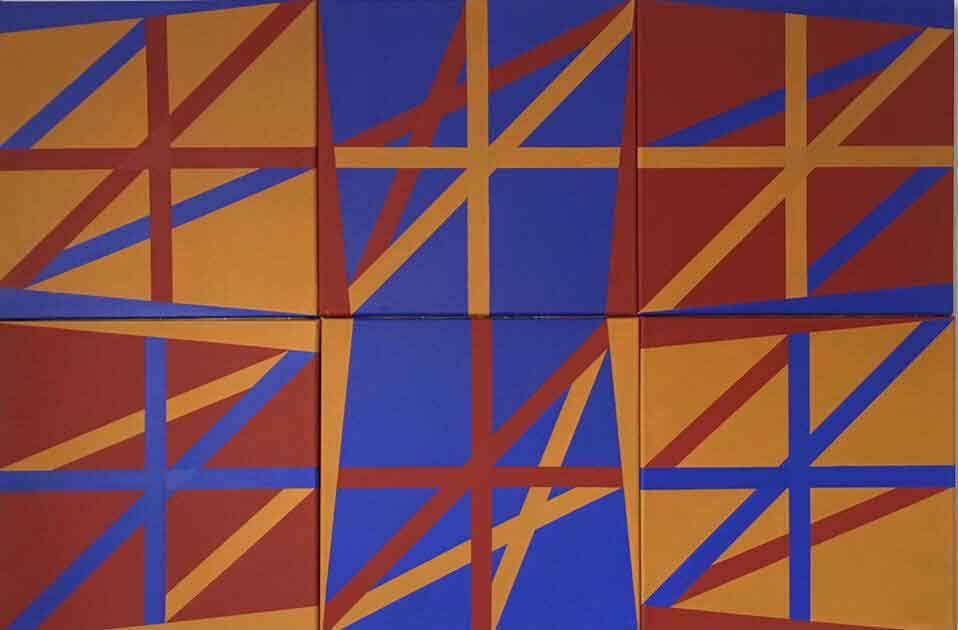
Retreintes Jaune Bleu Rouge, 60×90, acrylic on canvas, 2018
[ITA] Sono nato a Saâcy Sur Marne (Francia) nel 1955. Ho iniziato a dipingere all’età di quindici anni, su consiglio di alcuni artisti locali. Mi considero dunque un aut odidatta.
Dopo aver abbandonato la pittura per 15 anni, ho ripreso a dipingere nel 2014, facendo tabula rasa delle mie ricerche passate. Ho cominciato quindi a dipingere delle tele monocolore grigie, con linee orizzontali e verticali. Durante questo periodo i quadri di P. Mondrian e F. Morellet sono state una fonte di ispirazione e riflessione. Ho quindi introdotto delle diagonali e dei colori per completare i miei lavori.
Il mio metodo attuale si basa su di un lavoro strutturale geometrico: costruzione/decostruzione, composizione/decomposizione, dipinto/non dipinto, con delle linee di tensione inscritte in prospettive piane, su delle tele assemblate per moduli, e presentati come polittico.
[ENG] I was born in Saâcy Sur Marne (France) in 1955. I started painting at the age of fifteen, on the advice of some local artists. I therefore consider myself a self-taught person.
After leaving painting for 15 years, I started painting again in 2014, making a clean sweep of my past research. I then started painting monochrome gray canvases, with horizontal and vertical lines. During this period the paintings of P. Mondrian and F. Morellet were a source of inspiration and reflection. I then introduced diagonals and colors to complete my work.
My current method is based around a geometric structural work: construction / deconstruction, composition / decomposition, painting / non-painting, with lines of tension inscribed in plane perspectives, on canvases assembled by modules, for presentations in polyptych.
Ben Ben Cai – China

We are together, 40×50, oil on linen, 2019
[ITA] Benben Cai è nata nel 1974 e vive a Shanghai in Cina. Non ha una formazione artistica, ma crede che l’arte esiste nel cuore. In We are together l’artista esprime la paura della solitudine degli esseri umani e la tendenza a riunirsi in gruppo per formare un ambiente sicuro.
[ENG] Benben Cai was born in 1974 and lives in Shanghai in China. She does not have an artistic background, but believes that art exists in the heart. In We are together the artist expresses the fear of the loneliness of human beings, the tendency to come together in a group to form a safe environment.
Adelia Clavien – Switzerland

GirlNature III, 80×80, Mixed media photomontage printed on canvas, painted with various media (black sand, mortar, acrylic and resin), 2019
[ITA] Adélia Clavien di Miège (VS) è nata in Portogallo, vive in Svizzera dal 1981 e vive a Trélex. Sebbene abbia trascorso molto tempo nella comunità artistica del Vallese, ha frequentato i suoi primi corsi di pittura e ha iniziato a fotografare a San Gallo dove ha vissuto 10 anni. Curiosa e appassionata, Adelia è stata affascinata dalle arti fin da quando era giovane e ha lavorato nel settore IT per oltre 20 anni.
E’ un’artista autodidatta e si dedica con grande passione a questo lavoro. Esplora diverse tecniche di pittura (acrilico, foto-acrilico, vitrail ecc.) e usa la sua conoscenza della fotografia per creare dipinti originali, mescolando pittura e fotografia.
All’interno delle sue opere affronta varie tematiche che ci permettono di fuggire in un universo colorato e misterioso: l’universo di Adelia.
[ENG] Adélia Clavien from Miège (VS) is born in Portugal, has been living in Switzerland since 1981, and lives in Trélex. Although she spent a long time among the artistic community in Valais, she attended her first painting courses and started photography in St Gall where she lived 10 during years. Curious and passionate, Adélia has been fascinated by Arts since she was young and has been working in the IT domain for over 20 years.
As an artist, she works in an autodidactic and passionate manner. She explores various painting technics (acrylic, photo-acrylic, vitrail etc) and use her knowledge of photography to created original paintings mixed with photography.
The various presented themes allow us to escape in a colored and mysterious universe – Adelia’s universe.
Sito Web: http://www.adelia.ch
Lucilla Coletta (meLù) – Italy

Foglie danzanti, 30×60, colori acrilici su tela, 2015
[ITA] Architetto, da qualche anno mi dedico con passione alla decorazione pittorica, sia su supporti in legno che su tela. Continuo il mio percorso nella sperimentazione pittorica da autodidatta e mi piace firmare i miei lavori come ‘meLu’ in quanto la pittura rappresenta una parte di me dove confluiscono sensazioni ed emozioni e un mondo dove poter esprimere liberamente la mia creatività. In questo lavoro intitolato ‘ Foglie danzanti’, (colori acrilici su tela) le foglie di aspidistra fluttuano ed emergono da uno spazio scuro, profondo, come luce che nasce da un particolare stato d’animo, da una condizione esistenziale. L’aspidistra non a caso è una pianta robusta che si adatta anche nelle condizioni più sfavorevoli.
[ENG] Architect, for some years I have dedicated myself with passion to pictorial decoration, both on wooden supports and on canvas. I continue my journey into pictorial experimentation as a self-taught artist and I like to sign my works as “meLu” because painting represents a part of me where feelings and emotions come together and a world where I can freely express my creativity. In this work entitled “Dancing leaves”, (acrylic colors on canvas) aspidistra leaves fluctuate and emerge from a dark, deep space, like light that comes from a particular state of mind, from an existential condition. It is no coincidence that the aspidistra is a robust plant that adapts even in the most unfavorable conditions.
Rosanna Di Cecca – Italy
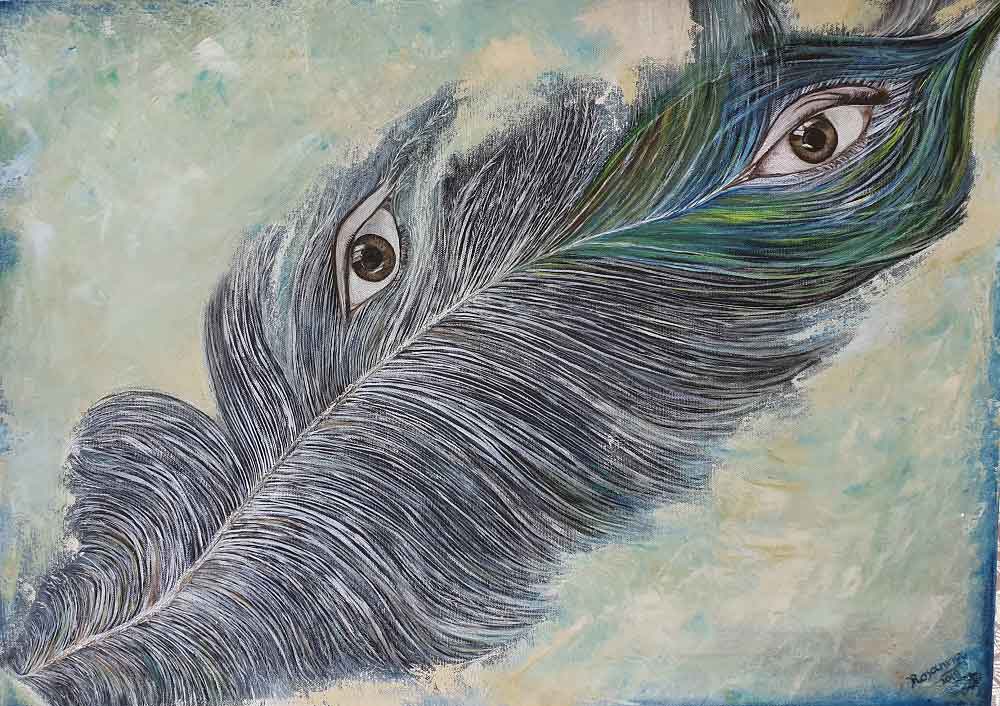
Anima, 50×70, colori, olio su tela nera, spatola e pennelli, 2018
[ITA] Un giorno qualcuno mi ha detto di avere una bella anima… così l’ho immaginata su di una tela nera come un’enorme e leggiadra piuma bianca, poi ho incastonato i miei occhi, poiché sono lo specchio dell’anima…lei sarà eterna…
[ENG] One day someone told me he had a beautiful soul… so I imagined it on a black canvas like a huge and graceful white feather, then I set my eyes, since I am the mirror of the soul… she will be eternal…
Daniele Digiuni – Italy

[ITA] Architetto di professione e artista per passione, Digiuni vive l’arte come libera manifestazione di un intimo desiderio di evasione dalla realtà. Una passione per la pittura innata che si porta dietro sin da bambino, egli fissa sulla tela bianca tutte le sensazioni e le pulsioni che riceve dall’esterno.
[ENG] Architect by profession and artist by passion, Digiuni lives art as a free manifestation of an intimate desire to escape from reality. A passion for innate painting that he carries with him as a child, he fixes on the white canvas all the sensations and impulses he receives from the outside.
Jelena Đokić – Serbia

Sunny Day, 28.8×50, watercolor on Fedrigoni 300gr, 2019
[ITA] Sono nata nel 1986 a Uzice, in Serbia. Mi sono laureata presso la Facoltà di Ingegneria Civile, Dipartimento delle Costruzioni (Università di Belgrado). Ho preso lezioni private in disegno dell’architettura e scultura a Belgrado e in seguito ho deciso di dedicarmi all’acquerello. I miei lavori sono disponibili nella Galleria M (Belgrado, vicino al Teatro Nazionale, nel centro città), anche nella nuova galleria che si apre qui a Zlatibor, dove lavorerò anch’io, a partire da quest’anno. Ho partecipato a mostre collettive in Serbia, Giappone, Canada, Cipro e nella colonia artistica “Putevima Save Sumanovica” a Sid, dove è nato il nostro famoso pittore Sava Sumanovic. I miei lavori sono in molte collezioni private (Texas, Regno Unito, New York, Irlanda, Germania, Illinois, Utah, Georgia, Svizzera, Australia …) Trovo ispirazione nelle cose semplici, nella bellezza interiore, nei colori, movimenti naturali del corpo umano, nei momenti vissuti.
[ENG] I was born in 1986 in Uzice, Serbia. I graduated from the Faculty of Civil Engineering, Construction Department (Belgrade University). Took private classes in architecture drawing and sculpting in Belgrade, decided to follow my true calling as a self-taught watercolor artist. My teacher is Charles Reid… My works are available in Gallery M (Belgrade, near the National Theater, city center), also in new Gallery opening here in Zlatibor, where I’m going to work as well, starting this year… I’ve participated in juried group exhibitions in Serbia, Japan, Canada,Cyprus, and in art colony ‘Putevima Save Sumanovica’ in Sid, where our famous painter Sava Sumanovic was born. My works are in many private collections (Texas, UK, New York, Ireland, Germany, Illinois, Utah, Georgia, Switzerland, Australia…) I find inspiration in simplicity, inner beauty, light, love, passion, people, freedom, color, flows, natural moves of human body, water, moment of now. Final work as well as the creation for me is the purpose of living with aim; the process of creating art is pure joy, love found (discovered) within ourselves, and shared with world.
Achao – France

Walking towards a better word, 95×113, Acrylic, pigments & varnish on free hanging canvas, 2018
[ITA] Sono un artista autodidatta e mi piace inventare la mia pratica artistica, elaborare i miei strumenti. Ho acquisito una solida base in campo scultoreo, che è il risultato di oltre quindici anni di pratica di laboratorio. Il mio lavoro artistico è essenzialmente quello di un pittore e di uno scultore. Tutta la mia creazione pittorica ha la sua origine nella scultura. I miei dipinti sono spesso rappresentazioni di templi o una disposizione di pietre intagliate disposte sulla tela. Le opere invitano ad un progresso spirituale, inteso come emancipazione del corpo, ad una spiritualità morbida e fluttuante.
Il dipinto Camminare verso una parola migliore è ispirato all’opera Eadweard Muybridge. Negli ultimi mesi ho concentrato la mia ricerca verso lo studio del corpo umano, così mi son tornate in mente le lastre fotografiche di Eadweard Muybridge. Nei primi anni della mia carriera da scultore, per studiare il corpo umano, ho fatto affidamento su queste foto, realizzando modelli in cera e argilla. Nel riscoprire le cronofotografie di Muybridge, ho riconosciuto personaggi familiari in alcuni dei modelli. Ho subito capito che non si trattava di dipingere le sequenze del movimento scomposto, perché sarebbe troppo evidente e avrei rischiato far passare tutto come un cliché. Inoltre, il mio occhio era attratto dal dettaglio di certe vignette, dalle espressioni su certi volti, dalle pose aggraziate dei corpi.
[ENG] I am a self-taught artist and I like to invent my artistic practice, develop my instruments. I have acquired a solid foundation in the sculptural field, which is the result of over fifteen years of laboratory practice. My artistic work is essentially that of a painter and a sculptor. All my pictorial creation has its origin in sculpture. My paintings are often representations of temples or an arrangement of carved stones arranged on the canvas. My works invite spiritual progress, understood as the emancipation of the body, to a soft and fluctuating spirituality.
The painting ‘Walking towards a better word’ is inspired by Eadweard Muybridge… Indeed, in recent months, my artistic research has brought me back to the human body. Naturally, the photographic plates of Eadweard Muybridge came to mind. I relied on these photos during my first years as a sculptor in order to study the human body, especially making models in wax and clay. In rediscovering Muybridge’s chronophotographies, I recognized some of the models as being familiar characters. I immediately understood that it would not be a question of painting the sequences of decomposed movement, as this would be too evident and risk being a cliché. Moreover, my eye was attracted to the detail of certain vignettes, the expressions on certain faces, the graceful postures of bodies…
Thomas Christian Koller – Austria

Entladung / Unloaded, 60×80, acrylic on canvas, 2019
[ITA] Thomas Christian Koller nasce a Vienna nel 1969. Per l’artista un’immagine vale più di mille parole e posta in un ambiente riesce a donare un tocco di individualità e stile, che si tratti di una fotografia o di un’opera pittorica.
Koller è fotografo e pittore. Le sue opere pittoriche sono tendenzialmente astratte e sono l’espressione più profonda della sua personalità.
[ENG] Thomas Christian Koller was born in Vienna in 1969. For the artist an image is worth a thousand words and placed in an environment he manages to give a touch of individuality and style, whether it is a photograph or a pictorial work.
Koller is a photographer and painter. His pictorial works tend to be abstract and are the deepest expression of his personality.
Krzysztof Konopka – Poland

Without title, 76×57, oil on canvas, 2016
[ITA] Krzysztof Konopka nato il 17.10.1963 a Piotrków Trybunalski in Polonia. Nel settembre 2014 egli compie un pellegrinaggio verso Santiago de Compostela e, tornato dalla Spagna inizia il suo cammino nel mondo della pittura. L’artista si esprime attraverso opere astratte realizzate con linee nitide e colori energici. La sua è una pittura emozionale, egli attraverso l’uso di spatole e colori ad olio, imprime sulla tela i suoi segni, lasciandosi trasportare da sensazioni e impulsi interni ed esterni. L’osservatore si perde nei segni dell’artista, scava nella struttura di quei movimenti e si lascia trasportare dalla propria immaginazione.
[ENG] Krzysztof Konopka born 17.10.1963 in Piotrków Trybunalski in Poland. In September 2014 he made a pilgrimage to Santiago de Compostela and, returning from Spain, began his journey into the world of painting. The artist expresses himself through abstract works created with clear lines and energetic colors. His is an emotional painting, he through the use of spatulas and oil paints, imprints his marks on the canvas, letting himself be transported by internal and external sensations and impulses. The observer gets lost in the artist’s signs, delves into the structure of those movements and lets himself be carried away by his own imagination.
Marilena La Mantia – Italy

Paesaggio 14 – Libia, 80×80, tecnica mista su tela, 2019
[ITA] Efficace, certa, corposa, vibrante con grandi slanci cromatici. Così si può racchiudere I’arte di Marilena La Mantia. Un’ arte dettata dai ricordi, dal vissuto personale, che non dimentica pero’ il buon modellato o le esatte proporzioni che rendono gradevoli ogni scena e dipinto intrapreso. Squarci di luoghi che spesso non sono catturati dagli altri, che invece rivivono in piena maestria nelle mani e nella sensibilità della pittrice. II riverbero ad accostarsl a temi come i paesaggi campestri o paesaggi cittadini, temi spesso troppe volte non considerati dalla aulica arte, ma che hanno un loro significato. I dipinti di Marilena La Mantia sono da scorgere uno a uno, assaporandone quasi la vita che è iscritta in essi.
[ENG] Effective, certain, full-bodied, vibrant with great chromatic impulses. Thus the art of Marilena La Mantia can be enclosed. An art dictated by memories, by personal experience, which however does not forget the good modeling or the exact proportions that make every scene and painting undertaken pleasing. Gaps in places that are often not captured by others, which instead relive in full mastery in the hands and in the sensitivity of the painter. The reverberation brings together themes such as rural landscapes or city landscapes, themes that are often too often not considered by courtly art, but that have their own meaning. The paintings of Marilena La Mantia are to be seen one by one, almost savoring the life that is inscribed in them.
Nunzia Lastella – Italy
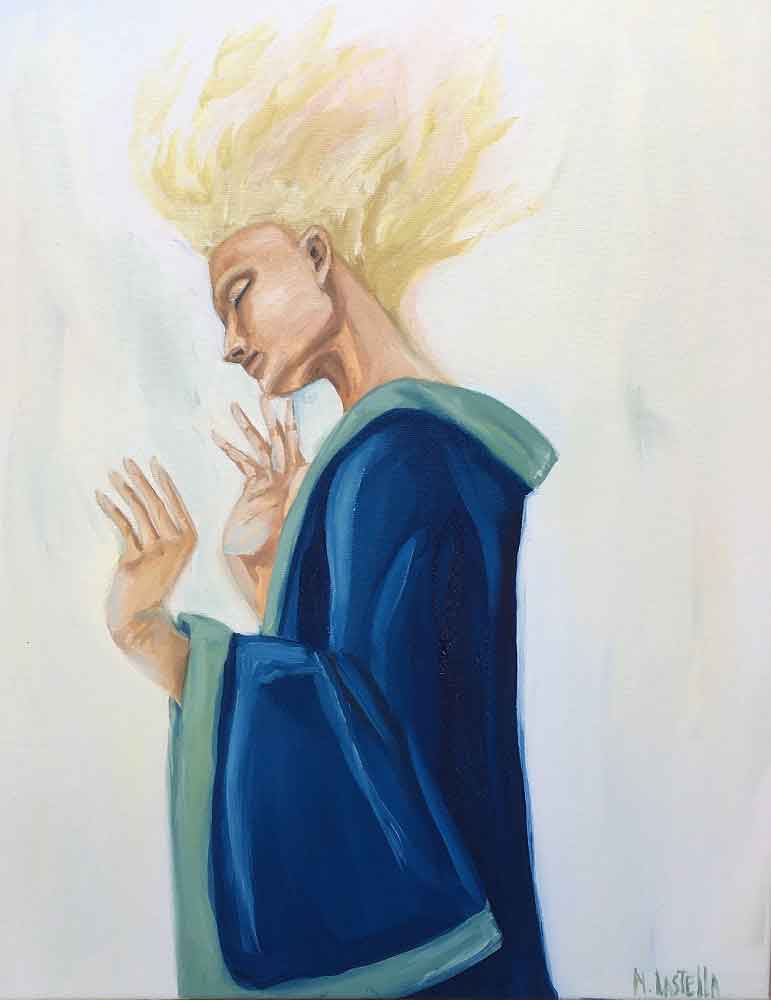
Pater Noster, 50×40, oil on canvas, 2019
[ITA] La spiritualità è un elemento che interessa una sfera molto intima dell’uomo e lo accompagna nei momenti più importanti e turbolenti della sua esistenza. La preghiera è lo strumento privilegiato della spiritualità, ma anche l’unico mezzo che abbiamo per comunicare col divino. Ho scelto di intitolare questo lavoro con la preghiera più importante e conosciuta dal mondo cristiano, non con la pretesa di spiegarla o disvelarla. Il Pater Noster rappresenta proprio quell’atteggiamento filiale del fedele che si abbandona nelle mani dell’Assoluto, non in reverenza o sottomissione, quanto piuttosto con fiducia incondizionata nell’amore del divino.
In questa tela ho cercato di rappresentare il momento dell’unione col divino: la preghiera che permette di cogliere la luce e il calore che scioglie i nodi del cuore. L’espressione del volto rilassata sta ad indicare il momento di pace strappato alla frenesia della vita, mentre i capelli, biondo platino, sembrano bruciare nel fuoco sacro e inestinguibile della mistica. Pur avendo scelto di usare colori freddi, tutto è immerso nella luce, dove il bianco non rappresenta un’assenza quanto piuttosto una presenza impalpabile che tutto abbraccia.
Il kimono è blu con dei bordi verde acqua. I colori del cielo e del mare non sono lasciati al caso, essi richiamano i due elementi più sconfinati con cui siamo abituati a rapportarci. L’intento è infatti quello di richiamare sulla sconfinatezza dell’animo umano, crogiuolo di sentimenti, tensioni, desideri e pulsioni. Tutto sembra ovattato e silenzioso, ma il silenzio della preghiera è ricco di contatto e partecipazione, a cui Dio risponde senza esitazione.
[ENG] Spirituality is an element that affects a very intimate sphere of man and accompanies him in the most important and turbulent moments of his existence. Prayer is the privileged instrument of spirituality, but also the only means we have for communicating with the divine. I chose to name this work with the most important and known prayer of the Christian world, not claiming to explain or unveil it. The Pater Noster represents precisely that filial attitude of the faithful who abandons themselves in the hands of the Absolute, not in reverence or submission, but rather with unconditional trust in the love of the divine.
In this painting I tried to represent the moment of union with the divine: prayer that allows us to grasp the light and the heat that melts the knots of the heart. The expression of the relaxed face indicates the moment of peace ripped from the frenzy of life, while the hair, platinum blonde, seems to burn in the sacred and inextinguishable fire of mysticism. Despite having chosen to use cold colors, everything is immersed in light, where white does not represent an absence but rather an impalpable presence that embraces everything.
The kimono is blue with water green edges. The colors of the sky and the sea are not left to chance, they recall the two most boundless elements we are used to dealing with. The intent is in fact to recall the boundlessness of the human soul, the melting pot of feelings, tensions, desires and impulses. Everything seems muffled and silent, but the silence of prayer is full of contact and participation, to which God answers without hesitation.
Donald Don Moon – U.S.A.

Impending, 24×30, acrylics on canvas, 2017
[ITA] E’ cresciuto in una famiglia di artisti tra membri dell’American Water Color Society (AWS) e galleristi in tutti gli Stati Uniti. Dopo una parentesi nel mondo del business e problemi personali che hanno segnato la sua vita, scopre l’attività di decorazione (muri o interni) e applicazione di pittura su metalli e macchinari industriali.
Negli anni ha sviluppato una notevole poliedricità: dall’arte folk all’espressionismo fino all’astrattismo. Di solito lavora contemporaneamente su due o tre pezzi, lasciando trapelare spesso un messaggio sociale o ambientale. In questo periodo sta lavorando su sculture upcycling, su un tipo di pittura a cera fredda con reazioni chimiche e meccaniche e su applicazioni di gesso. Vive e lavora full time nel suo studio-galleria a FAVO, nella downtown di Orlando negli States e partecipa al “First Friday art show” ogni mese. E’ presente stabilmente in una decina di galleria in Florida.
[ENG] He grew up in a family of artists including members of the American Water Color Society (AWS) and gallery owners throughout the United States. After a break in the business world and personal problems that have marked his life, he discovers the activity of decoration (walls or interiors) and application of painting on metals and industrial machinery.
Over the years it has developed a remarkable versatility: from folk art to expressionism to abstract art. Usually works on two or three pieces at the same time, often leaving a social or environmental message. In this period he is working on upcycling sculptures, on a type of cold wax painting with chemical and mechanical reactions and on plaster applications. He lives and works full time in his FAVO studio-gallery, in downtown Orlando in the States and takes part in the “First Friday art show” every month. It is permanently present in about ten galleries in Florida.
Kevin J. Padilla – U.S.A.

Between the Veil, 61×76, acrylics on canvas, 2019
[ITA] Kevin Padilla è un artista autodidatta che ama sperimentare e mescolare tecniche diverse. L’artista ha sviluppato un linguaggio astratto che si focalizza, in particolare, sulla contrapposizione di colori chiari e scuri. In Between the Veil ha lasciato fluire le sue emozioni sulla tela per comunicare all’osservatore il proprio subconscio, una parte di se stesso.
[ENG] Kevin Padilla is a self-taught artist who loves to experiment and mix different techniques. The artist has developed an abstract language that focuses, in particular, on the contrast of light and dark colors. In Between the Veil he let his emotions flow onto the canvas to communicate his subconscious, a part of himself, to the observer.
Panicos Panagi – Cyprus

The People, 50×40, oil acrylic on canvas, 2019
[ITA] Panicos Panagi è nato a Famagusta Cipro nel 1965. Ha studiato Storia dell’Arte all’Accademia Americana di Cipro. Ha continuato i suoi studi presso la “Petros Ptochopoulos Art school” di Cipro e ha esposto all’estero, negli Stati Uniti e in varie parti d’Europa.
Ha vinto 2 premi internazionali con i suoi Paesaggi. I suoi dipinti storici e le sue esposizioni negli ultimi 4 anni, hanno fatto salire di livello della sua arte e un comitato internazionale gli ha assegnato il titolo di “maestro d’arte”. I dipinti di Panicos si trovano anche nelle gallerie delle ambasciate della Grecia di 4 Paesi diversi.
Nella sua ultima mostra nel museo ha esposto la sua collezione Alexander La grande civiltà greca con altri artisti internazionali provenienti da Russia, Bulgaria, Grecia e Cipro. Attualmente sta lavorando ad una nuova serie di paesaggi astratti. Panicos sarà in mostra in estate e a settembre nelle gallerie italiane.
[ENG] Panicos panagi was born in Famagusta Cyprus in 1965. He studied Art History at the American Academy of Cyprus. He continued his studies at the “Petros Ptochopoulos Art school” in Cyprus and exhibited abroad, in the United States and in various parts of Europe.
He has won 2 international awards with his Landscapes. His historical paintings and exhibitions over the past 4 years have raised his art level and an international committee has awarded him the title of “master of art”. Panicos paintings are also found in the galleries of Greek embassies in 4 different countries.
In his last exhibition in the museum he exhibited his Alexander collection The great Greek civilization with other international artists from Russia, Bulgaria, Greece and Cyprus. He is currently working on a new series of abstract landscapes. Panicos will be on display in summer and in September in Italian galleries.
Tiziana Pennacchi – Italy

Figli unici, 30×30, foto digitale, 2018
[ITA] Mi chiamo Tiziana Pennacchi, sono nata in Toscana ma vivo a Roma dal 2006, dove lavoro, studio e faccio la mamma. Ho iniziato a scattare a 17 anni con una vecchia macchinetta fotografica trovata in un cassetto di mio padre, da allora la fotografia mi ha sempre accompagnato come strumento di ricerca personale ed emotiva.
Ciò che ci circonda non è sempre visibile, ma a volte in un attimo può accadere di tutto e la fotografia non è solo un fermare quel momento per me, ma un modo per cercare e vedere l’umanità che incontro nel mio quotidiano, il desiderio di riconoscersi nei gesti, nelle emozioni, nelle storie che l’obiettivo svela.
[ENG] My name is Tiziana Pennacchi, I was born in Tuscany but I live in Rome since 2006, where I work, study and work as a mother. I started shooting at 17 with an old camera found in my father’s drawer, since then photography has always accompanied me as a tool for personal and emotional research.
What surrounds us is not always visible, but sometimes everything can happen in a moment and photography is not just a stop for me, but a way to search and see the humanity I encounter in my daily life, the desire to recognize oneself in the gestures, in the emotions, in the stories that the lens reveals.
Raffaele Saccà – Italy
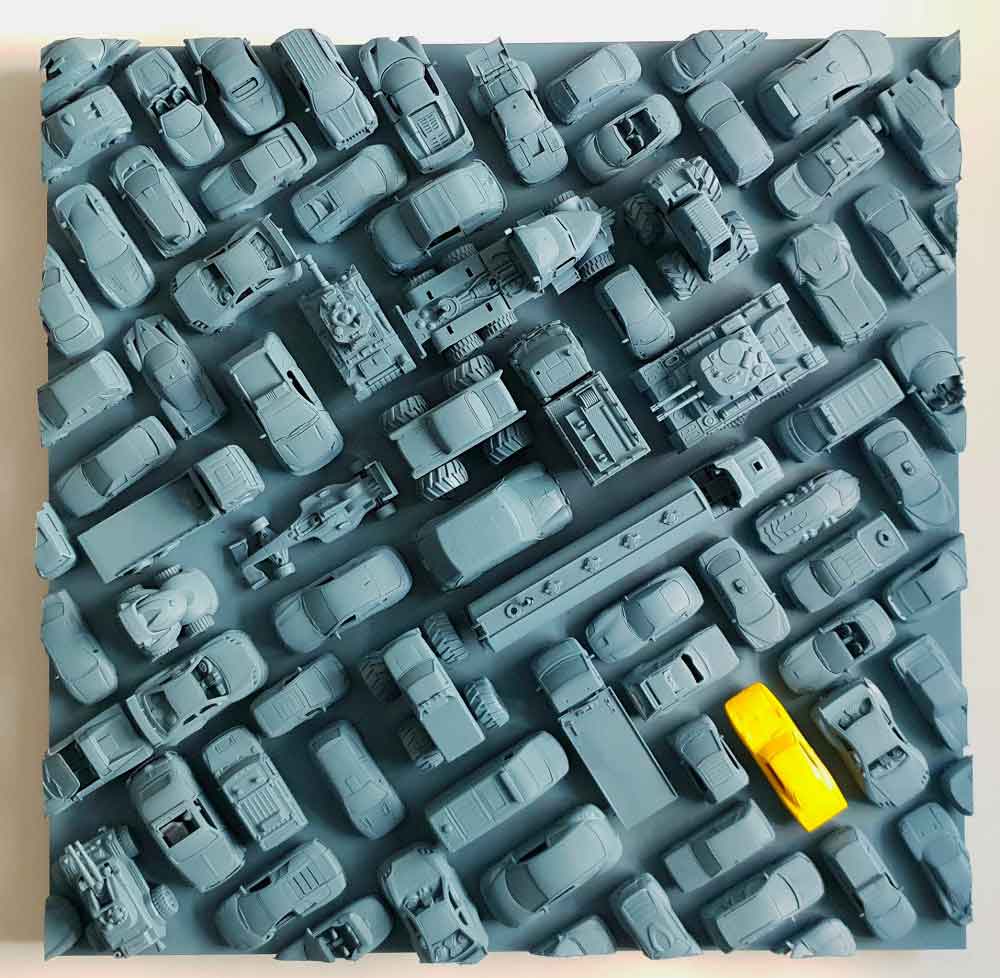
Visione soggettiva di un ingorgo IV, 80×80, modellini di macchine e smalto su legno (tecnica mista), 2018
[ITA] Raffaele Saccà è architetto e artista. Ha tenuto la sua ultima mostra personale lo scorso ottobre a Roma, durante la Roma Art Week, presso la galleria Spazio 40. Le sue opere sono esposte anche Torino presso la galleria Grafiche Manzoni.
Il modulo espressivo di Saccà è una visione labirintica degli ingorghi cittadini; le sue opere sono simboli di omologazione, dove il colore è l’elemento uniformante, oltre al pattern ossessivo nel quale traccia in maniera netta strade, incroci e circuiti dell’urbe.
A rompere la monocromia e la monotonia di un loop inarrestabile l’artista inserisce un’entità di disturbo, una macchina che, per diverso colore, differisce dall’insieme e che in quel tutto cerca di staccarsi come a voler fuggire da quegli ingranaggi “chapliniani”. L’occhio, inevitabilmente, cade su questo particolare, che funge da evidenziatore, attirando lo sguardo per effetto di dissonanza. Quella nota “stonata” è colui che nel traffico si sente vittima e non carnefice ma che nella realtà ricopre invece entrambi i ruoli, inconsapevolmente.
Nelle sue visioni personali la velocità è congelata, come in un fermo immagine; come la vita stessa che in balia del caos quotidiano si ferma, sobbalza e scalpita; anch’essa imbottigliata nei propri pensieri. Questa immobilità trova una via d’uscita nella creazione di spazi mentali inusuali in cui inserire ulteriori chiavi di lettura come l’accumulo compulsivo, di cui l’automobile è uno dei simboli più rappresentativi.
[ENG] Raffaele Saccà is an architect and artist. He held his last personal exhibition last October in Rome, during the Art Week of Rome, at the Spazio 40 gallery. His works are also exhibited at the Grafiche Manzoni gallery.
Saccà’s expressive form is a labyrinthine vision of city jams; his works are symbols of homologation, where color is the unifying element, in addition to the obsessive pattern in which he clearly traces roads, intersections and circuits of the city.
To break the monochrome and the monotony of an unstoppable loop, the artist inserts a disturbing entity, a machine that differs from the set by its different color and tries to break away from it as if to flee from those “chaplinian” gears “. The eye inevitably falls on this detail, which acts as a highlighter, attracting the eye due to dissonance. That “stoned” note is the one who feels like a victim and not an executioner in traffic, but who in reality covers both roles, unknowingly.
In his personal visions the speed is frozen, as in a still image; like life itself that at the mercy of daily chaos stops, bounces and paws; also bottled up in one’s thoughts. This immobility finds a way out in the creation of unusual mental spaces in which to insert additional interpretations such as the compulsive accumulation, of which the car is one of the most representative symbols.
Razaval Gabriel Stama – England
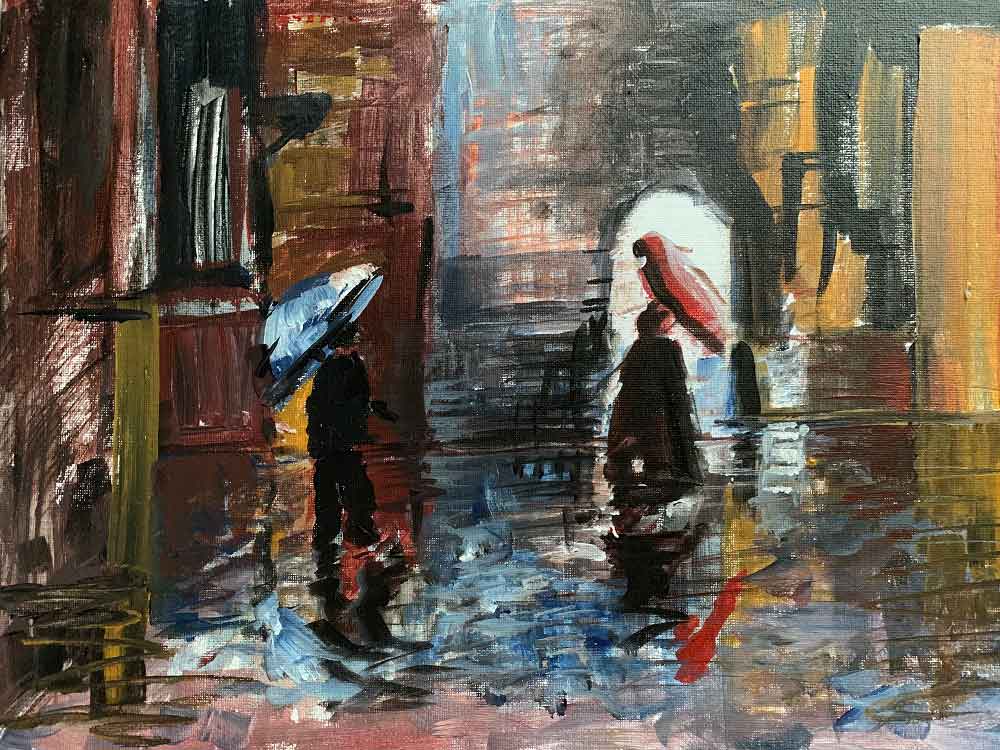
Couple in the rain, 30×40, acrylic on canvas, 2019
[ITA] L’incontro di una coppia in una giornata uggiosa di primavera. D’improvviso il sole che appare dietro un’arcata e l’atmosfera che si illumina. I colori caldi e freddi accostati sulla tela vibrano come in quadro impressionista e, tra questi, spiccano le silhoutte dei due personaggi raffigurati. L’arco illuminato in particolare mette in evidenza la figura femminile, quasi a simboleggiare una speranza. Il messaggio che l’artista vuole far trapelare è chiaro: in qualsiasi circostanza spiacevole arriveranno sempre momenti migliori.
[ENG] The meeting of a couple on a gloomy spring day. Suddenly the sun that appears behind an arch and the atmosphere that lights up. The warm and cold colors combined on the canvas vibrate as in an impressionist painting and, among these, the silhouettes of the two characters depicted stand out. The illuminated arch in particular highlights the female figure, as if to symbolize hope. The message the artist wants to convey is clear: in any unpleasant circumstances, better moments will always come.
Karin Walser – Austria
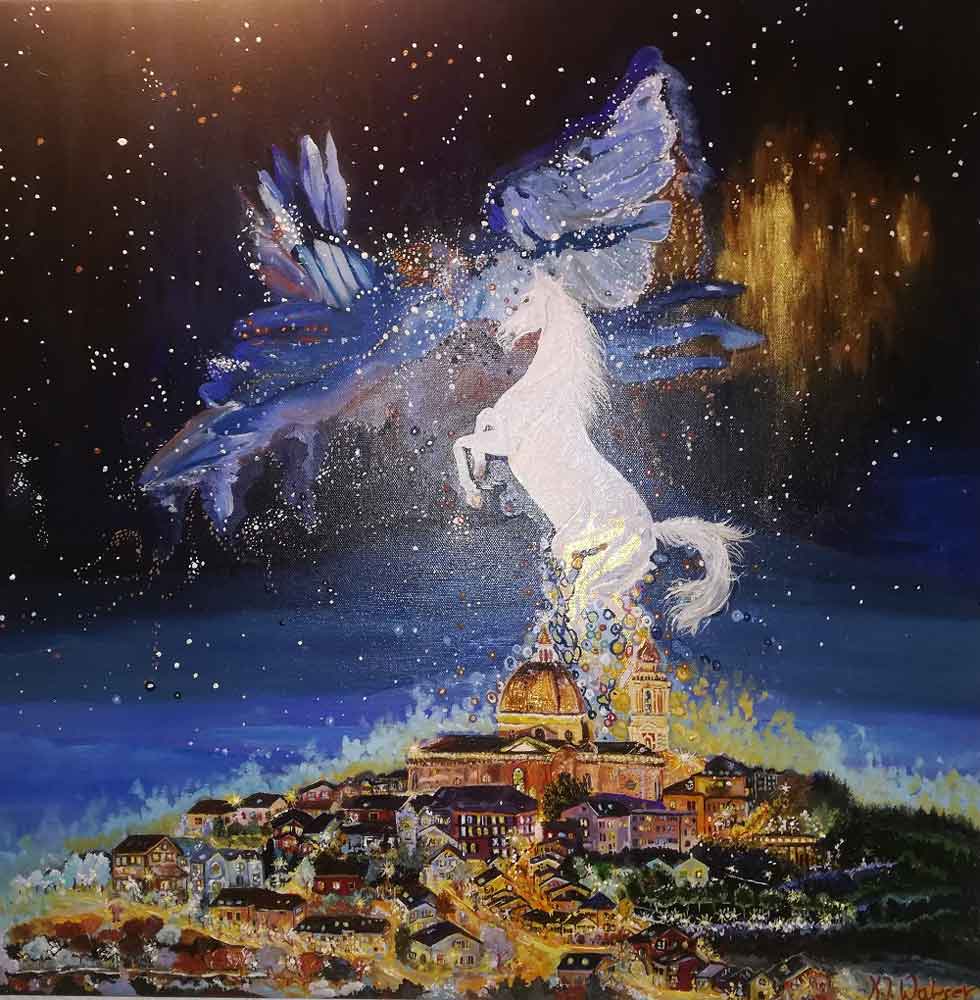
Love of the future, 60×60, oil paints, gold leaf, 2017
[ITA] Karin Walser classe 1964. Ha prima iniziato a frequentare una make up artist e più tardi ha frequentato gli studi con un professore di Parigi, studiando pittura e disegno. Karin espone i suoi lavori in pubblico dal 2003, e da qualche anno le opere sono in mostra permanente a Grafarth, vicino Monaco.
[ENG] Karin Walser, born in 1964. He first started attending a make-up artist and later studied with a professor in Paris, studying painting and drawing. Karin has been showing her works in public since 2003, and for some years the works have been on permanent display in Grafarth, near Munich.

